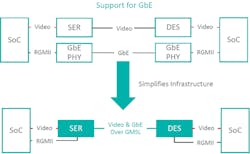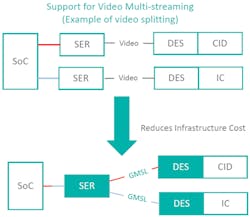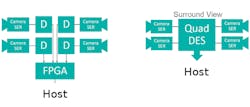Competing with the likes of automotive Ethernet and MOST, Maxim Integrated Products is determined to link the connected car via its proprietary Gigabit Multimedia Serial Link (GMSL) SERDES technology. What sets GMSL apart is its multistream support over a single cable, which can be up to 15 m with coax or up to 10 to 15 m with a shielded twisted pair. It can aggregate protocols like Ethernet and DisplayPort over a single link while meeting automotive electromagnetic-compatibility (EMC) requirements.
1. Maxim’s Gigabit Multimedia Serial Link (GMSL) can support multiple protocols over the same link, such as video and Ethernet.
GMSL is a multigigabit, point-to-point connection that targets the automotive space. The next version, to be released in 2018, provides 4K video support. The current version can support 3K video and Gigabit Ethernet over a single link (Fig. 1).
Maxim tailored its family of SERDES chips to handle multiple data streams. This includes the ability to split video streams (Fig. 2) to cope with the many displays in a car, such as the information cluster (IC) and the central information display (CID).
2. The ability to split video streams from an SoC allows a single data stream to be split into multiple streams to drive multiple displays in an automotive information cluster (IC) and the central information display (CID).
The company already has a quad deserializer designed to work with surround-view camera clusters (Fig. 3). Its key feature is the backchannel support that GMSL provides versus the unidirectional support of many other SERDES implementations. This enables the operation of bidirectional protocols like Ethernet. It also allows the quad SERDES in this example to synchronize the four cameras so that they deliver frames in sync with each other. This significantly simplifies the host’s processing of the information, and eliminates the need for an FPGA that would normally do the job.
3. Maxim developed a quad deserializer that’s designed to work with surround-view camera clusters. The backchannel is used to synchronize the cameras so that frames are delivered in a synchronous fashion to the host.
Furthermore, GMSL incorporates bidirectional diagnostics, which makes it possible to test the interfaces and cables. This works during development as well as when deployed in the field, providing superior field diagnostics. The eye-mapping tool essentially offers embedded sampling scope functionality. The link margin tool can measure the minimum transmit amplitude required to run an error-free link in both directions.
GMSL is proprietary, but its functionality is hard to argue with. Reducing the number of cables in a connected car is important, as is reliability. To improve the latter, GMSL utilizes spread-spectrum technology.





